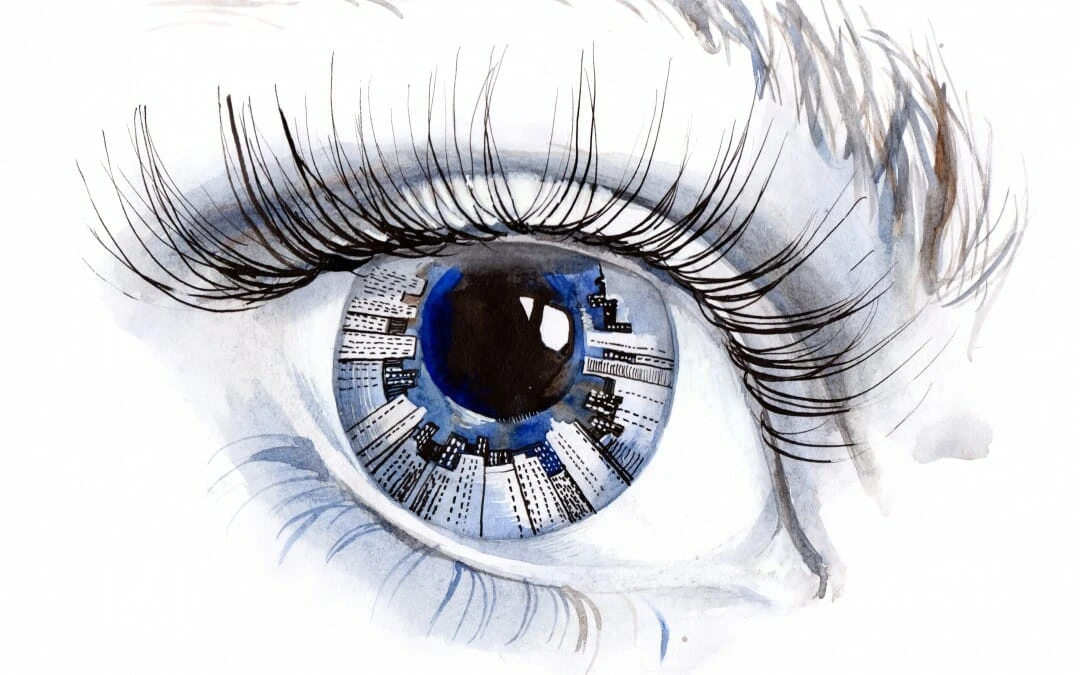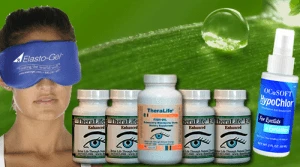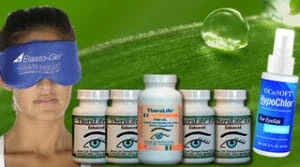How To Wear Eye Make Up Again ?
Irradicate Blepharitis so you can wear all the eye makeup you want. Get your life back on track.
Blepharitis is the inflammation of eyelids. Root cause is chronic dry eyes. Treat your dry eyes and keep blepharitis at bay.
Powerful Blepharitis Treatment- The Total Solution -TheraLife
TheraLife has the complete solution – treat blepharitis, dry eyes and MGD at the same time. Get optimized, fast results. Clinically Proven, Doctors Recommended. 100% Money Back Guaranteed.
TheraLife All In One Starter Kit
1. TheraLife Eye capsules – to restore and revive
2. Omega 3- fish oil – anti-inflammatory, lubricate and thickens tears
3. Hot compress – melt blockages of oil glands (MGD)
4. Avenova eyelid cleanser- lid hygiene, relief blepharitis
Add To Cart
Customer Success Stories
Blepharitis MGD Recovery
I have had blepharitis/MGD that would come concurrent with a pink eye for quite a few years, but it has always gone away pretty quickly on its own. However, this last time, blepharitis and dry eye did not leave, and it became pretty disruptive to my life. My eye doctor gave me eye drops, making my eyes feel drier. I felt as though I had no hope for my eyes, and they were going to keep getting worse and worse. Despite being reasonably skeptical, I finally decided to try Theralife, and I’m So glad I did. I’ve now been taking it for just over two weeks, and I already feel so much better. This morning I woke up, and my eyes were almost white instead of bright red. My blurry vision cleared up, the stickiness gone from my eyes, and the stinging had virtually gone.
I’m looking forward to them getting better and better. Thanks so much!”
Cindy, USA
For more customer stories, click here
Why TheraLfe?
- Stuck in Vicious Cycle of Dry Eyes, Blepharitis, MGD
- Target All 3 with TheraLife Protocol
- Powerful All -Natural Anti-inflammatories.
- Relief From Inside Out- No More Drops
- 100% Money Back Guaranteed
How Does TheraLife Eye Work?
Our all-natural supplements for chronic dry eye relief address the fundamental cause of painful, inflamed and dry eyes: underactive tear secretion. Only TheraLife® targets this issue intra-cellularly to restore balance and end the cycle of dry, itchy red eyes. TheraLife® promotes your own cellular functioning, in order to provide natural dry eye relief with your own body’s healing tears. After treatment with TheraLife®, you will once again have a natural ability to make tears, eliminating inflammation and dryness.
What Is In TheraLife Eye
TheraLife Eye capsules is a proprietary patented formula composed of plant extracts, vitamins and minerals. For more details, click here.
Powerful Blepharitis Treatment- The Total Solution -TheraLife
TheraLife has the complete solution – treat blepharitis, dry eyes and MGD at the same time. Get optimized, fast results. Clinically Proven, Doctors Recommended. 100% Money Back Guaranteed.
TheraLife All In One Starter Kit
1. TheraLife Eye capsules – to restore and revive
2. Omega 3- fish oil – anti-inflammatory, lubricate and thickens tears
3. Hot compress – melt blockages of oil glands (MGD)
4. Avenova eyelid cleanser- lid hygiene, relief blepharitis
Add To Cart
Eyeliner for Blepharitis
Wearing makeup can worsen blepharitis. For people with severe flares or chronic ongoing problems, no eye makeup during recovery.
Don’t use eyeliner on the back edges of your eyelids behind the eyelashes. If you are already suffering from blepharitis, avoid wearing makeup until it has completely cleared.
Once blepharitis is improved, one can resume make-up. TheraLife can help.
Recommendations
No eye make-up while blepharitis is active.
Eye makeup interferes with eyelid hygiene and massage treatments necessary for Blepharitis treatment and recovery.
Recommendation for you to use an anti-dandruff shampoo for your scalp and eyebrows.
What kind of eye make can you use with mild blepharitis?
It is best to choose brands formulated without the more synthetic parabens and waxes.
Why is eye makeup a concern for blepharitis?
Because blepharitis involve eye lids and eye lashes, eye make up becomes intolerable. We highly recommend people with Blepharitis do not wear any make up until they totally recover.
The chemicals in makeup can be toxic and even more so for people with dry eye or blepharitis who already have sensitive eyes and may be undergoing treatment.
The application of cosmetic products to eyelashes and eyelids has been a concern for eye doctors for a long time.
Research has shown that there is a migration of cosmetic microparticles into the tear film within 30 minutes of application.
Eye makeup and contact lenses
These cosmetics can stick to the corneal, the conjunctiva, and other ocular surface surfaces that result in contact dermatitis and loss of eyelashes.
The ocular surface plays a vital role in protecting your eyes. In fact, it experiences the most frequent injuries and infections due to its exposure to the environment.
The ocular surface keeps your eyes comfortable and helps you protect from external hazards and stabilizing your tear film.
The impact of cosmetics on contact lenses affects the wettability and visible surface deposition.
We recommend do not wear contact lenses while you have active blepharitis. Use spectacles instead.
Eye Makeup Tips for Sensitive Eyes
If you’re prone to blepharitis, it’s sensible to choose cosmetics that won’t irritate your sensitive eyes.
Here are some tips for safer makeup!
- Chose hypoallergenic brands, and be very aware of how your skin reacts when you use something for the first time.
- If you feel irritation, even if the eye pencil or mascara is brand new, then stop using it. You could try doing a patch test before using a new
- Stick to mascaras specifically developed for sensitive eyes Mascaras that have been dermatologically tested and approved for those who are sensitive to skin conditions are always the best to use.
- Non waterproof mascara so you don’t need chemicals to get it off.
- Other experts suggest avoiding powder eye shadow, especially anything with glitter.
- When choosing eye make up, always make sure it is ophthalmologist tested for allergens.
Keep your eyes safe
No matter the brand or type of eye makeup you choose to use, we recommend the following tips to keep your eyes safe.
- Remove eye makeup completely before bed using warm water or a gentle makeup remover.
- Be careful not to touch your eyes and use a soft cloth or organic cotton pads.
- Clean your makeup brushes daily with a gentle cleanser.
- Keep your eyes as clean as possible. Make sure you remove all eye makeup before you go to sleep.
- Primers make powders stick, particularly those with sunscreen, so can be helpful and safer as the eye makeup stays in place better lessening unwanted migration into the tear film and eye surface.
- Clean brushes with MAC cleaner. I’ll also use baby shampoo for a real deep clean as well.
- Wear eye makeup on special occasions.
TheraLife All In One Starter Kit
1. TheraLife Eye capsules – to restore and revive
2. Omega 3- fish oil – anti-inflammatory, lubricate and thickens tears
3. Hot compress – melt blockages of oil glands (MGD)
4. Avenova eyelid cleanser- lid hygiene, relief blepharitis
Add To CartHow to remover eye makeup
Use Eucerin eye make up remover or Inkey List oat cleansing balm (depending on if I’m wearing make up), as neither of these cause any irritation for me.
Then use a hot damp flannel on eyes for about 5 minutes. Then massage gently around the eyes.
Finally dilute some baby shampoo in water, dip in a cotton bud and cleanse along the lash line (different buds for each eye). Finish off with some eye drops, I like Blink intensive tears.
How does eye make-up affect contact lenses?
Why do we look at contact lenses?
Because it can experiment in a laboratory setting, the research focused on hand cream, eye make-up removers, and mascara impact on contact lenses.
The mascaras caused the most visible deposits on the lenses. Mascara also deposits on eyelashes.
Furthermore, Non-watery proof mascara was more accessible to remove than the waterproof type. The peroxide lens care system partially removed the hand clean. The extent of removal varied for different lenses.
Cosmetics on contact lenses caused visual problems and lens discomfort.
Waterproof mascaras are difficult to remove even with many cleaning cycles. We should pay increased attention to how cosmetics affect blepharitis, ocular dryness, and discomfort symptoms, especially in contact lens wearers.
Make-up can worsen blepharitis, and for patients with severe flares or chronic ongoing problems necessitate a make-up “holiday.” Many patients can resume make-up once the blepharitis is improved.
Still, it is best to choose brands formulated without the more synthetic parabens and waxes.
Can I still wear make-up?
Not wearing eye make-up, while the disease is more active, is also a good idea since it can get in the way of eyelid hygiene and massage treatments. With any kind of blepharitis, we recommend that you use an anti-dandruff shampoo for your scalp and eyebrows.
Powerful Blepharitis Treatment- The Total Solution -TheraLife
TheraLife has the complete solution – treat blepharitis, dry eyes and MGD at the same time. Get optimized, fast results. Clinically Proven, Doctors Recommended. 100% Money Back Guaranteed.
TheraLife All In One Starter Kit
1. TheraLife Eye capsules – to restore and revive
2. Omega 3- fish oil – anti-inflammatory, lubricate and thickens tears
3. Hot compress – melt blockages of oil glands (MGD)
4. Avenova eyelid cleanser- lid hygiene, relief blepharitis
Add To Cart
Prevention
Make sure you remove all eye makeup before you go to sleep. Don’t use eyeliner on the back edges of your eyelids behind the eyelashes.
Blepharitis its common for the symptoms to reappear so it’s crucial to do as much as possible to keep the symptoms at bay. As a makeup wearer, having blepharitis can be dreadful. It’s a catch-22, you want to wear makeup but know this could irritate the blepharitis even further, especially eye makeup like mascara.
Primers make powders stick, particularly those with sunscreen, so can be helpful and safer as the eye makeup stays in place better lessening unwanted migration into the tear film and eye surface.
TheraLife All In One Starter Kit
1. TheraLife Eye capsules – to restore and revive
2. Omega 3- fish oil – anti-inflammatory, lubricate and thickens tears
3. Hot compress – melt blockages of oil glands (MGD)
4. Avenova eyelid cleanser- lid hygiene, relief blepharitis
Add To CartFrequently asked questions
What eye makeup can I use with blepharitis?
One natural option is to use organic coconut oil and it doesn’t contain harsh preservatives. Avoid powder and glitter-based eye shadows, foundations and blush, and recommend cream-based make-up instead.
Is it OK to wear eye makeup with blepharitis?
Eye makeup worsens blepharitis, therefore we recommend no eye makeup until your blepharitis clears. Control your blepharitis with TheraLife.
What ingredients should you avoid with blepharitis?
Avoid the following ingredients:
- Alcohol.
- Acetyl hexapeptide-3.
- Benzalkonium chloride (BAK or BAC)
- Butylene glycol, ethylenediaminetetraacetic acid (EDTA)
- Formaldehyde and formaldehyde donors.
- Isopropyl cloprostenate.
- Parabens.
- Phenoxyethanol.
Can blepharitis be caused by mascara?
TheraLife All In One Starter Kit
1. TheraLife Eye capsules – to restore and revive
2. Omega 3- fish oil – anti-inflammatory, lubricate and thickens tears
3. Hot compress – melt blockages of oil glands (MGD)
4. Avenova eyelid cleanser- lid hygiene, relief blepharitis
Add To CartReferences
- Wetzel CL. Permanent cosmetics. Plast Surg Nurs. 2012;32(3):117–9.
- Abah ER, Oladigbolu KK, Rafindadi AL, Audu O. Eyelash extension use among female students in a Tertiary Institution in Nigeria: A study of kaduna polytechnic, Kaduna. Niger J Clin Pract. 2017;20(12):1639–43.
- Vagefi MR, Dragan L, Hughes SM, Klippenstein KA, Seiff SR, Woog JJ. Adverse reactions to permanent eyeliner tattoo. Ophthalmic Plast Reconstr Surg. 2006;22(1):48–51.
- De M, Marshak H, Uzcategui N, Chang E. Full-thickness eyelid penetration during cosmetic blepharopigmentation causing eye injury. J Cosmet Dermatol. 2008;7(1):35–8.
- Lee YB, Kim JJ, Hyon JY, Wee WR, Shin YJ. Eyelid Tattooing Induces Meibomian Gland Loss and Tear Film Instability. Cornea. 2015;34(7):750–5.
- Ali L, Foulds JS, Abdul Ghaffar S. Severe eyelid allergic contact dermatitis secondary to eyelash tint: two case reports. Contact Dermatitis. 2017;77(1):59–60.
- Kaiserman I. Severe allergic blepharoconjunctivitis induced by a dye for eyelashes and eyebrows. Ocul Immunol Inflamm. 2003;11(2):149–51.
- Pas-Wyroslak A, Wiszniewska M, Krecisz B, Swierczynska-Machura D, Palczynski C, Walusiak-Skorupa J. Contact blepharoconjunctivitis due to black henna–a case report. Int J Occup Med Environ Health. 2012;25(2):196–9.
- Koffuor G, Kyei S, Gyanfosu L, Afari C. Effect of the Working Environment on Oculo-Visual Health of Some Sand and Stone Miners in Ghana. J Environ Occup Sci. 2012;1(2)
- Amano Y, Sugimoto Y, Sugita M. Ocular disorders due to eyelash extensions. Cornea. 2012;31(2):121–5.
- Kim YJ, Chung JK. Bilateral Eyelid Contact Dermatitis and Toxic Conjunctivitis due to Acrylate-Containing Glue. Ann Dermatol. 2014;26(4):543–4.
- Dahlin J, Hindsen M, Persson C, Isaksson M. What lash stylists and dermatologists should know! Contact Dermatitis. 2016;75(5):317–9.
- Shanmugam S, Wilkinson M. Allergic contact dermatitis caused by a cyanoacrylate-containing false eyelash glue. Contact Dermatitis. 2012;67(5):309–10.
- Ullrich K, Saha N. Semipermanent eyelash extensions causing bacterial keratitis: a case report. Can J Ophthalmol. 2013;48(3):e50–1.
- Simons KB, Payne CM, Heyde RR. Blepharopigmentation: histopathologic observations and X-ray microanalysis. Ophthalmic Plast Reconstr Surg. 1988;4(1):57–62.
- Calzado L, Gamo R, Pinedo F, Vicente FJ, Naz E, Gomez-de la Fuente E, et al. Granulomatous dermatitis due to blepharopigmentation. J Eur Acad Dermatol Venereol. 2008;22(2):235–6.
- Moshirfar M, Espandar L, Kurz C, Mamalis N. Inadvertent pigmentation of the limbus during cosmetic blepharopigmentation. Cornea. 2009;28(6):712–3.
- Mselle J. The role of eyelash dyes in allergic eye diseases. Trop Doct. 2004;34(4):235–6.
- Rodin FH. Eyelash Dyeing: Some Severe Eye and Systemic Symptoms Resulting Therefrom. Cal West Med. 1934;40(5):372–4.
- Vogel TA, Coenraads PJ, Schuttelaar ML. Allergic contact dermatitis presenting as severe and persistent blepharoconjunctivitis and centrofacial oedema after dyeing of eyelashes. Contact Dermatitis. 2014;71(5):304–6.
- Wachsmuth R, Wilkinson M. Loss of eyelashes after use of a tinting mascara containing PPD. Contact Dermatitis. 2006;54(3):169–70.
- Awan MA, Lockington D, Ramaesh K. Severe allergic blepharoconjunctivitis after eyelash colouring. Eye (Lond) 2010;24(1):200–1.
- Gallardo MJ, Randleman JB, Price KM, Johnson DA, Acosta S, Grossniklaus HE, et al. Ocular argyrosis after long-term self-application of eyelash tint. Am J Ophthalmol. 2006;141(1):198–200.
- Kind F, Scherer K, Bircher AJ. Contact dermatitis to para-phenylenediamine in hair dye following sensitization to black henna tattoos – an ongoing problem. J Dtsch Dermatol Ges. 2012;10(8):572–8.
- Teixeira M, de Wachter L, Ronsyn E, Goossens A. Contact allergy to para-phenylenediamine in a permanent eyelash dye. Contact Dermatitis. 2006;55(2):92–4.
- Hansson C, Thorneby-Andersson K. Allergic contact dermatitis from 2-chloro-p-phenylenediamine in a cream dye for eyelashes and eyebrows. Contact Dermatitis. 2001;45(4):235–6.
- Schwarze HP, Giordano-Labadie F, Loche F, Gorguet MB, Bazex J. Delayed-hypersensitivity granulomatous reaction induced by blepharopigmentation with aluminum-silicate. J Am Acad Dermatol. 2000;42(5 Pt 2):888–91.
- Lu CW, Liu XF, Zhou DD, Kong YJ, Qi XF, Liu TT, et al. Bilateral diffuse lamellar keratitis triggered by permanent eyeliner tattoo treatment: A case report. Exp Ther Med. 2017;14(1):283–5.






